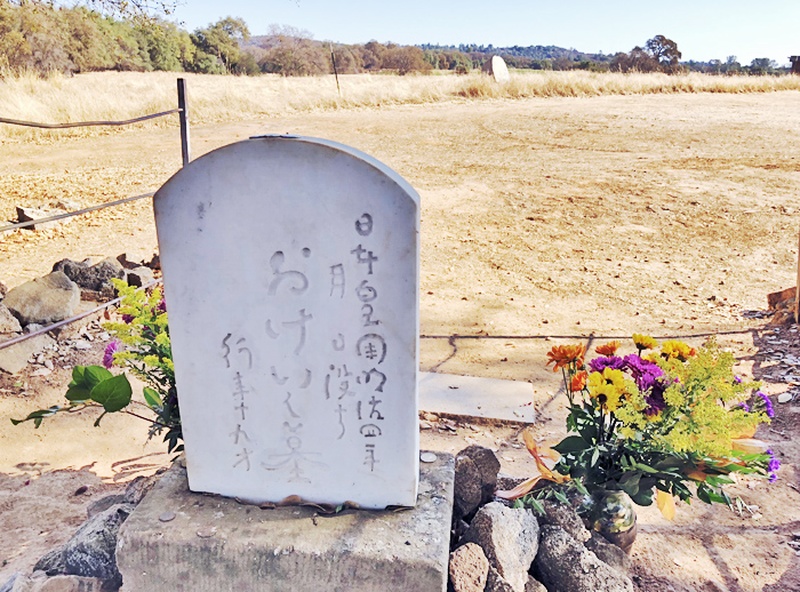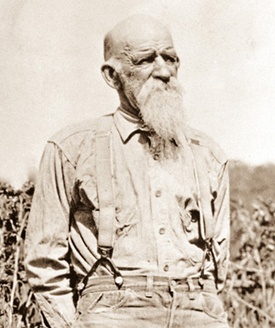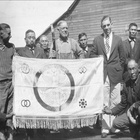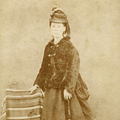The story of the first Japanese woman to be buried in American soil emerges from history’s shadows.
The Wakamatsu Colony had collapsed and the pioneering dreams of the Japanese immigrants were shattered. The once-hopeful colonists dispersed, some deciding to return to Japan, while others chose to stay in California.
A neighboring farming family named Veerkamp purchased the site of the colony in Gold Hill, and hired some members of the former settlement to stay on for work.
The Veerkamps retained Matsunosuke Sakurai, a former Aizu samurai. Also staying on was a woman named Okei, who had served in Japan as a nanny for Schnell, a Prussian who led the first wave of immigrants who went on to establish the Wakamatsu Colony.
Okei is believed to be the daughter of Okiku and Bunkichi Ito, who had worked as a carpenter in Aizu Wakamatsu. The Rafu contacted officials in City of Aizu Wakamatsu, and sadly, Okei’s family registry has been lost to history over the decades, so it is difficult to seek further information about her childhood.
At the age of 17, Okei left the safety of her parents’ home and embarked on the journey to California, only to find an uncertain future two years later, after the failure of Wakamatsu Colony. The security offered by the Schnell family was gone, and she found herself alone in a foreign country, forced to grapple with a different language and culture.
Okei had the good fortune to fall into the loving embrace of the Veerkamp family, who took her into their home and treated her as their own daughter.
Themselves immigrants from Germany, Francis and Louisa Veerkamp had six sons, and Okei became the nanny to their younger boys.
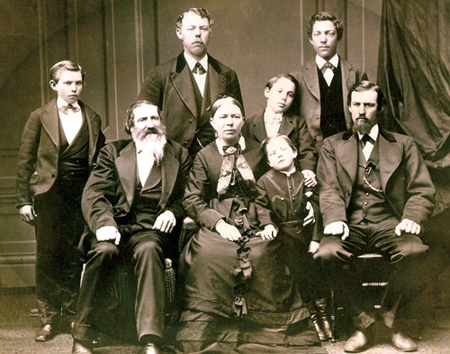
“Francis and Louisa’s children were all boys, so they cherished Okei like their own daughter. I heard that especially Luisa dreamed that one of her sons would marry Okei someday,” said Herb Tanimoto, a docent at the American River Conservancy, the nonprofit preservation group that now owns and manages the Wakamatsu Colony site.
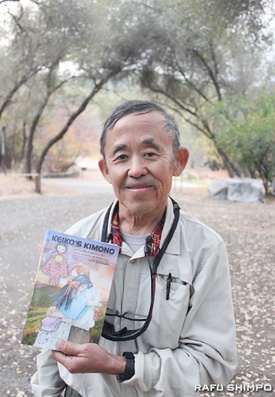
Tanimoto is the author of Keiko’s Kimono, a historical novel based on Okei’s life. He said the Veerkamp family commonly called Okei their “Japanese princess.”
Loved as she was by her adoptive family, Okei contracted a sudden and severe fever in the summer of 1871 and died just three days later. She was only 19 years old.
It is believed that Okei’s parents and family in Japan never received the news of her death, spending their rest of their lives not knowing her unfortunate fate.
Legend has it that Okei often stood alone on a small hilltop in Gold Hill, illuminated by the California sunset gazing in the direction of her hometown of Aizu. Perhaps she was imagining the parents she could never see in person, or wondering where life would lead her. This serene hilltop is now Okei’s final resting place.
Several years later, Matsunosuke Sakurai, the former samurai who stayed on to work for the Veerkamp family, took steps to properly honor the memory of Okei. Despite its substantial cost, Sakurai somehow managed to purchase a marble headstone and constructed a gravesite for her atop her hill.
Over more than a century of enduring the elements, Okei’s original gravestone became cracked and weathered and has been replaced with a marble replica.
Okei’s final destination looks toward her hometown of Aizu Wakamatsu. In 1957, a monument to her memory was built on Mt. Seaburi in Aizu Wakamatsu, gazing in the direction of Okei’s gravesite in California.
A Newspaper Shines Light on Okei’s Story
Year after year, Okei remained alone and anonymous in the rich California soil. There were no visitors to the gravesite, no flowers offered in mourning for the teenager whose dreams were cut short.
The existence of the first Japanese woman buried on the American mainland seemed completely forgotten – until her story was brought out of history’s shadows by a chance report in a local Japanese American newspaper.
An Aug. 29, 1913 article in the Shin Sekai (New World) alerted the Nikkei community in the region to the existence of a Japanese gravestone built in 1871 near the town of Coloma. The story made no mention of the name of Okei, but explained that a Japanese group used to live in the area, dispersing after failing to establish a tea farm. The group is widely assumed to be the Wakamatsu Colony.
Furthermore, the year 1871 matched the time of Okei’s death, and the Gold Hill location of her gravesite is near Coloma.
Despite the published connections, however, Okei’s existence remained largely unknown within the Nikkei community.
A few years later, Bunjiro Takeda, a writer for the San Francisco-based Nichibei Shinbun, wrote about Okei’s gravesite. Takeda is now considered the person who introduced the story of Okei to a worldwide audience.
Following information from a local orchard owner named Tametaro Kunishi, Takeda tracked down Okei’s gravesite and wrote the article that lifted her history from the realm of the unknown.
A Nichibei Shinbun story dated July 12, 1924 explained, “Eight years have passed since I wrote about Okei’s grave and introduced her to the outside world.” The writer used what seemed to be a pen name, but the piece is assumed by many to be composed by Takeda, referring to his own 1916 article.
More than half a century since her death, Okei’s existence was now known to the world.
During the 1920s and ’30s, local Japanese newspapers frequently published articles about the first Japanese girl buried in American soil, creating a sensation in the Nikkei community. To mourn the teenage pioneer, tours to Okei’s gravesite were often organized by Nikkei groups, and a radio program about her life was produced.
A Loving Son and the Emerging Image of Okei
From existing news articles and local stories emerge a picture of Okei as a beloved daughter of a local family. A Nichibei Shinbun story published April 23, 1931 includes an interview with the owner of the site where her gravestone sits.
The land owner is Henry Veerkamp (1851- 1934), the eldest son of Francis and Louisa Veerkamp. He recalled spending time with Okei since she was taken into his home, describing her as good friend of whom he was very fond.
“Okei was a beautiful girl,” he told the writer. At the time of the interview, Henry Veerkamp was 80 years old, but the memories of Okei from when he himself would have been 20 seemed laden with an undeniable affection.
“He must have loved her a great deal, for when he begins to talk about the girl, his deep-set eyes seem to brighten a bit. No doubt,” the article read. Henry added that Okei never wore Western dresses, always opting for her colorful kimono.
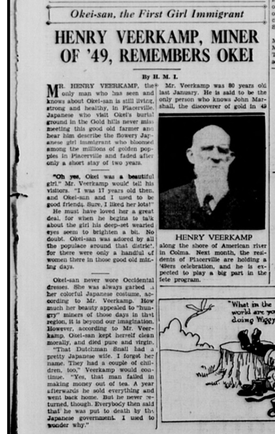
In the book Pacific Pioneers by John Van Sant, Henry Veerkamp is quoted as describing Okei as “a nice girl, and when she wore a Japanese kimono she was really beautiful. She couldn’t speak English very much but was bright, and soon learnt needlework and cooking from my mother, who was very fond of her.”
From these testimonies and reports, the life of Okei as someone cherished by her local family and community has emerged from obscurity.
Before his passing, Henry Veerkamp was often interviewed by writers who visited the gravesite. In one Nichibei Shinbun article from May 14, 1931, he described how Okei passed away in one room of the Veerkamp family home. He also kept a Japanese short sword and banner believed to be among Schnell’s belongings, proudly showing them to reporters.
In another Nichibei story published Sept. 26, 1927, Henry recalled two other Japanese women whose names were Miwa and Okiyo.
A Faithful Samurai in a New Land
Okei’s death in 1871 left but two of the original Japanese colonists in Gold Hill, Kuninosuke Masumizu and Matsunosuke Sakurai, the former Aizu samurai who took it upon himself to ensure the young girl’s grave was marked with a proper headstone.
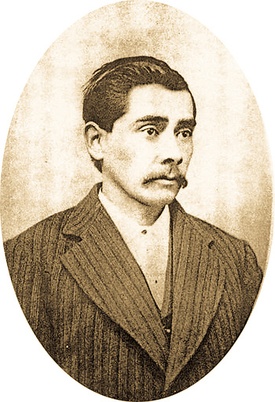
Born in 1834, Sakurai was around the age of 35 when he joined the group who traveled to California. He stayed in Gold Hill following the collapse of the Wakamatsu Colony, hired along with Okei by the Veerkamp family, to help work their farm.
Sakurai soon earned the respect and trust of the Veerkamps, to the extent that he became the manager of their business. He remained faithful to the family for some 30 years before his passing on Feb. 25, 1901. For decades, where he was laid to rest was forgotten, until being discovered in 2017.
In 2014, Pearl Butler, a Veerkamp family descendant, was interviewed by the American River Conservancy. She died three years later at the age of 98, but not before recalling conversations about Sakurai that revealed some crucial bits of information.
Butler said that when she was a teenager, her father, Adolph Veerkamp, had shown her the location of Sakurai’s gravesite. Sakurai had worked under Adolph’s father, Egbert Veerkamp.
Bulter explained that Egbert’s wife, Mary, had cared for the terminally ill Sakurai, and after his death, the Veerkamp family took care of his final arrangements.
In 2017, more than 100 years after his death, a grave-site was constructed for Sakurai, and a memorial ceremony was held with Nikkei priests attending.
At his passing, Sakurai was 67 years old and never married, finishing his life of service in California, and carrying the samurai oath of loyalty throughout his life, from Japan and into a life in the New World.
*This article was originally published by The Rafu Shimpo on February 2, 2019.
© 2019 Junko Yoshida / Rafu Shimpo


